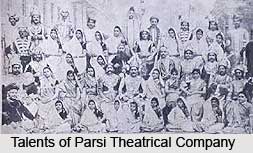 Parsee Stage Players are pioneering Parsi Theatre Company formed in Bombay. This was formed by owner Framji Dalai and actor Pestanji Dhanjibhai in 1853. Kavasji Kohidaru, Nanabhai Ranina, and Kavasji Bilimoria were other actor-members and such eminent co opted patrons as Professor Dadabhai Naoroji and Dr Bhaudaji Lad played very important roles in developing the troupe, which produced 27 plays by 1861. The first, `Rustam Zabuli and Sohrab` was dramatized from Firdausi`s Shahnama and ending with a very interesting local drama. Dhanji Garak was written by Jahangir Vaccha. This was staged at the Grant Road Theatre on 29 October 1853. A full house of Europeans, Parsis, and Hindus apparently enjoyed themselves. It was a historic premiere for four urban theatrical traditions. These are Parsi, Gujarati, Urdu, and Hindi. The Bombay Gazette, Telegraph and Courier, and Times took note of this event, congratulating the young group for their success. The criticism of the play had a significant part in improvement of the stage.
Parsee Stage Players are pioneering Parsi Theatre Company formed in Bombay. This was formed by owner Framji Dalai and actor Pestanji Dhanjibhai in 1853. Kavasji Kohidaru, Nanabhai Ranina, and Kavasji Bilimoria were other actor-members and such eminent co opted patrons as Professor Dadabhai Naoroji and Dr Bhaudaji Lad played very important roles in developing the troupe, which produced 27 plays by 1861. The first, `Rustam Zabuli and Sohrab` was dramatized from Firdausi`s Shahnama and ending with a very interesting local drama. Dhanji Garak was written by Jahangir Vaccha. This was staged at the Grant Road Theatre on 29 October 1853. A full house of Europeans, Parsis, and Hindus apparently enjoyed themselves. It was a historic premiere for four urban theatrical traditions. These are Parsi, Gujarati, Urdu, and Hindi. The Bombay Gazette, Telegraph and Courier, and Times took note of this event, congratulating the young group for their success. The criticism of the play had a significant part in improvement of the stage.
The Players later presented Padshah Faredun dastan i.e. `Emperor Faredun`s Story` in 1855. It was based on the Persian Shahnama, and some plays of Shakespeare. Each performance concluded with a farce on socially relevant local events. Even after the company folded up, this tradition continued, till the last breath of the professional Gujarati theatre in 1979. Songs irrelevant to the play sung by a sort of chorus in the midst of dialogue, quaint clothes and make-up, some Italian and Spanish costumes, oil or carbide lamps, chandeliers, and painted curtains were typical features. Farcical devices were gradually incorporated in the main drama. In a manner not unlike that of Elizabethan boys` companies, Parsi lads gifted with melodious voices, good looks, and charming personalities were selected as actors.
This article is a stub. You can enrich by adding more information to it. Send your Write Up to content@indianetzone.com




















